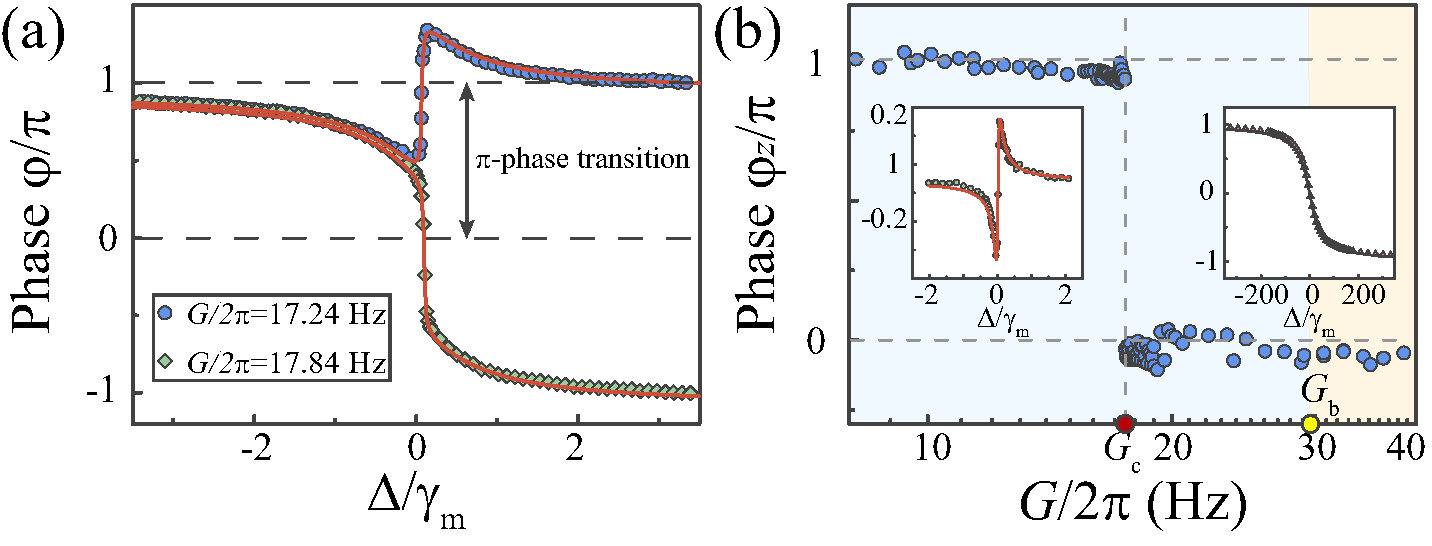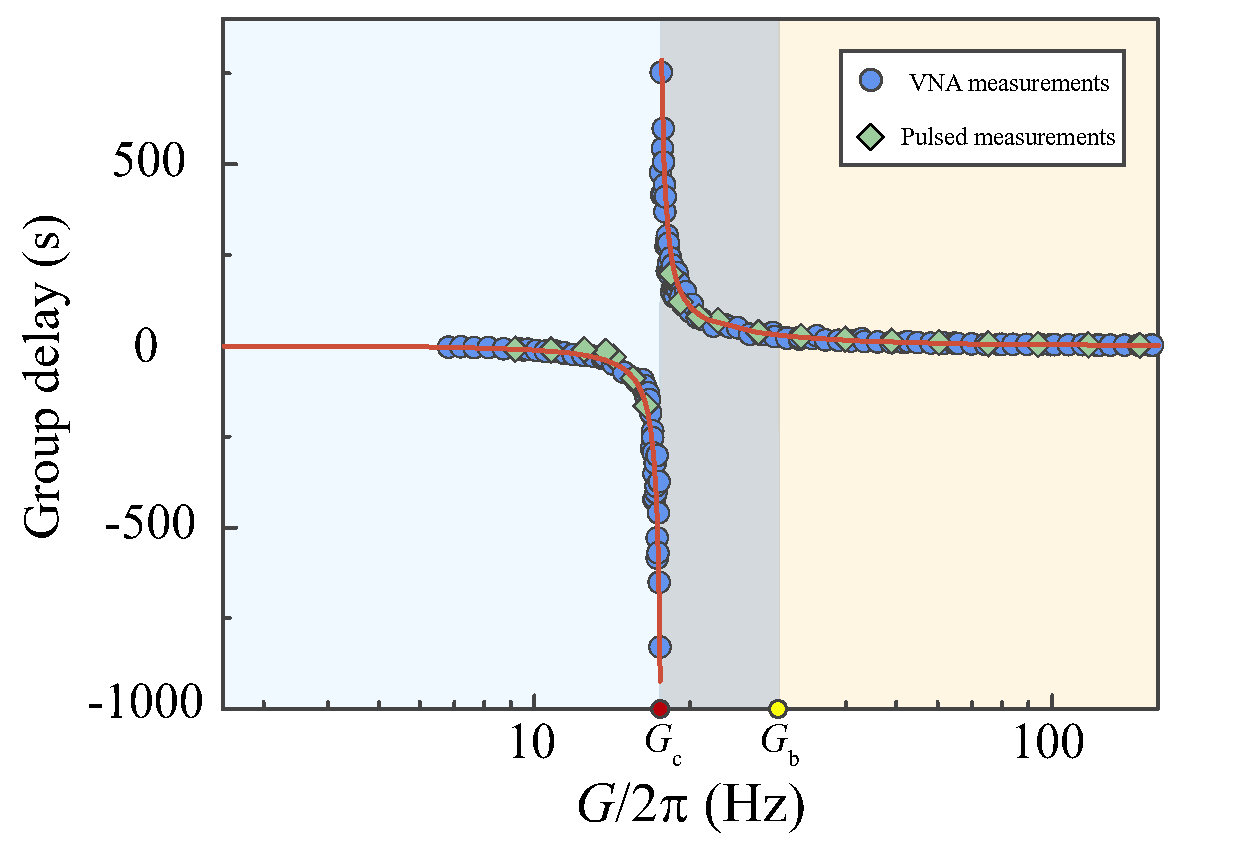The topological quantum computing team has made important experimental progress in the field of superconducting cavity optomechanical anti-lasing and quantum information storage
2021/12/31
On December 29, 2021, Liu Yulong, assistant researcher, and others of the topological quantum computing team from the Beijing Academy of Quantum Information Sciences, cooperated with the research group of Professor Mika Sillanpaa from Aalto University in Finland and achieved important experimental progress in superconducting cavity optomechanical anti-lasing and quantum information storage. Related work was published in Physical Review Letters with the title "Optomechanical Anti-lasing with Infinite Group Delay at a Phase Singularity".
Anti-lasing is the time-reversal of laser corresponding to the coherent perfect absorption of incident electromagnetic waves -- Anti-laser has important applications in many fields such as improving the efficiency of photovoltaic power generation, biomedical inspection, and ultra-high sensitivity detection. Under normal circumstances, by adjusting the relative phase of the incident electromagnetic wave to induce interference cancellation, the device can achieve the coherent perfect absorption (CPA) of the incident electromagnetic wave. In addition to interference cancellation based on multiple beams of light, the symmetry breaking of parity-time (PT) inversion symmetry can also induce spontaneous absorption of incident electromagnetic waves. In the PT-symmetry broken system, the nonlinearity can be greatly enhanced and then is further developed to coherently trap photons. With the rapid development of quantum optics technology and its applications in quantum communication and computing, it becomes particularly important to study CPA in a few photon or entangled states. The above scheme requires a controllable gain medium, strong magnetism, and other materials into the device, which are very challenging to realize on a solid-state quantum processing chip, which largely limits the observation of CPA and anti-laser in superconducting circuits based solid quantum devices.

FIG. 1. (a) The 3D microwave cavity and a mechanically compliant capacitor. (b) Schematic showing the placement of the metalized membrane over the antenna pads. (c) Lumped-element model of the device.
Cavity optomechanical devices have important applications in the fields of macroscopic quantum effects, precision measurement, and quantum information processing --The mechanical oscillators can be cooled to the ground state by using sideband pump, and they can still have a long coherence time after entering the quantum region. The quantized acoustic mode can couple to electromagnetic waves in various frequency bands. Therefore, the cavity optomechanical system is a promising platform to study the quantum storage, conversion and even work as a class of coherent interface devices. Moreover, the quantum cavity optomechanical devices have important application value in the fields of solid-state quantum information processing and precision measurement that reach the quantum limit. As an important type of quantum coherent interface, optomechanical devices will also play a key role in the construction of large-scale qubit chips and quantum networks.

FIG. 2. (a) Phase φ versus detuning Δ for two coupling strengths close to the critical coupling Gc on both sides. (b) Phase φz at cavity resonance versus coupling strength G.
Assistant researcher Liu Yulong of our topological quantum computing team, senior engineer Liu Qichun, postdoctoral researcher Chen Zhen, etc. cooperated with the research group of Professor Mika from Aalto University in Finland, to construct a superconducting cavity optomechanical device in the microwave frequency domain and carried out experiment gobbling up high-frequency photons based on the low-frequency mechanical vibration. Through the sideband pumping, the thermal phonon of the mechanical vibrator is parametrically converted into a high-frequency photon through an anti-Stokes process and absorbs a thermal phonon, so the sideband cooling of the vibrator can be achieved. At the same time, the converted photons can destructively interfere with the incident electromagnetic waves and then achieve optical anti-laser, which is based on the mechanically induced destructive interference and CPA. The experimentally constructed superconducting cavity optomechanical device is shown in Figure 1. The vibrating silicon nitride film has a quality factor as high as ten to the eighth power (Q~108), i.e., a very small linewidth (on the order of millihertz). The vibration of the silicon nitride film changes the mechanical capacitance in the cavity, which in turn induces a shift in the resonant frequency of the microwave cavity, forming a dispersion-type optomechanical coupling. Through red-sideband pumping, the optomechanical interaction works inside the parametric linear coupling region. Therefore, it is possible to accurately control the intensity of linearized optomechanical coupling by accurately controlling the energy of the external pump in the experiment.
The CPA of the incident laser and the singular transition of the phase around the resonant frequency -- In this work, based on the anti-Stokes scattering induced by the optomechanical interaction and the destructive interference between different transition paths, it is realized controllable absorption of high-frequency laser photons by the low-frequency phonons. Through precise control of the interference intensity (the experimental accuracy is close to the single-photon radiation pressure) until that the coupling strength is infinitely close to the critical coupling Gc, we can achieve an energy absorption of more than 50dB for the incident laser. When the coupling strength reaches the critical coupling strength, the complete interference cancellation can be achieved and coherent perfect absorption is achieved; when the boundary coupling strength is exceeded, the sideband photons sufficiently exceed the background spectral line of the resonant cavity, and the optomechanical induced transparency occurs.
The group delay at the singular point and abrupt transition between the fast- and slow-light -- At the critical coupling strength, except for the observation of the coherent perfect absorption, this work also revealed that the phase at the resonance frequency correspondingly exhibits a π-phase transition. As shown in Figure 2, this abrupt change causes the phase-to-frequency derivative to evolve discontinuously with the coupling strength increasing, implying the appearance of a first-order phase transition. Here, the derivative of the phase with respect to frequency detuning corresponds to the group velocity of electromagnetic wave propagation. Especially when the phase slope is at the critical coupling strength, positive- and negative-slope reverses. Therefore, the phase transition will also induce a singular point in the group velocity, and the nearby group delay changes from negative infinity to positive infinity. Figure 3 more clearly shows that the group delay near the critical coupling strength tends to be positive or negative infinity, and as the coupling strength exceeds Gc, fast- and slow-light transition occurs. Normally, electromagnetically induced transparency and absorption can be used for slow light and fast light, respectively. This work shows that when coherent perfect absorption occurs, the phase transition will change the properties of the system's fast- and slow-light behaviors. Even if the amplitude manifests as electromagnetically induced absorption, the fast light in the usual sense will be transformed into slow light. Benefiting from the high-quality factor of the mechanical vibrator, when the device is working in the typical electromagnetically induced transparency regime, the group delay still arrives the order of one second, which is an improvement of more than three orders of magnitude compared to the storage time reported in the current literatures. The work reveals the group delay is near-infinite when works around the singular point. In addition to the technology and schemes based on spin or frequency combs, the realization of optical anti-laser and phase singularity research will inspire new ways for the realization of ultra-long time quantum state storage. The article further pointed out the possibility of the existence of multiple phase transition and looked forward to the specific scheme to be realized in the optical gain amplification zone. This work can also be extended to ferromagnetic spins, photonic molecules, circuit QED, surface plasmons, quantum dots and other quantum systems.

FIG. 3. The group delay at zero detuning (τz) versus coupling strength G are measured.
The above work was supported by the National Key Research and Development Program of China, the National Natural Science Foundation of China, and the Science Challenge Project, and by the Academy of Finland.
Original Link: https://journals.aps.org/prl/abstract/10.1103/PhysRevLett.127.273603
 中文
中文 Email
Email QCloud
QCloud Log in
Log in
